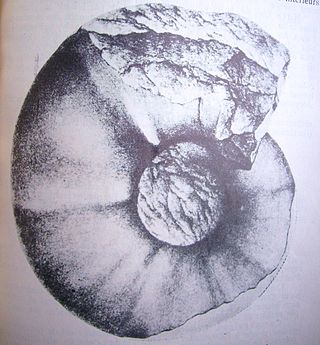
Abrytasites (Abrytusites) is an extinct genus of cephalopods belonging to the Ammonoidea subclass. The genus was named after the ancient Roman town of Abrittus, located near the present Bulgarian city of Razgrad. There are several described species of Abrytasites, including A. thieuloyi, A. julianyi, and A. neumayri. They are inflated, with constrictions, have rather thick ribs springing irregularly, singly or in pairs, from umbilical bullae. Their inner whorls closely resemble types species of Valdedorsella. This animal lived 125–136.4 million years ago during the Hauterivian and the Barremian in Europe and western Africa.

Anahamulina is an extinct ammonoid cephalopod genus from the Lower Cretaceous. Named by Hyatt, 1900.
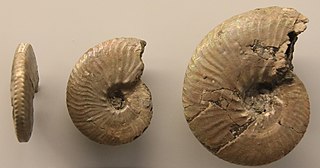
Anahoplites is a genus of rather involute, compressed hoplitid ammonites with flat sides, narrow flat or grooved venters, and flexious ribs or striae arising from weak umbilicle tubercles that end in fine dense ventrolateral nodes. The elements of their sutures are short, wide and jaggedy. Specimens of Annahoplites have diameters typically in the range of 4–6 centimetres (1.6–2.4 in) although some with diameters of as much as 19 centimetres (7.5 in) have been reported. The genus lived during the Cretaceous, from the Middle to the late Albian.
Astiericeras is an ammonite from the Lower Cretaceous, the shell of which is evolute, stout; outer whorl with strong, well spaced, transverse ribs that cross smoothly over the broad venter; early whorls with lateral tubercles. The outer, mature whorl separates from the coil but hooks back quickly, referred to as a heteromorph.

Barremites is an ammonoid cephalopod genus belonging to the family Desmoceratidae, that lived during the Hauterivian and Barremian stages of the Early Cretaceous.
Anisoceratidae is an extinct family of heteromorph ammonites which belong to the Ancyloceratina superfamily Turrilitoidea. Members of the family range is from the lower Albian to the upper Turonian. The family is possibly derived from a member of the Hamitidae.

Nipponites is an extinct genus of heteromorph ammonites. The shells of Nipponites form "ox-bow" bends, resulting in some of the most bizarre shapes seen among ammonites.
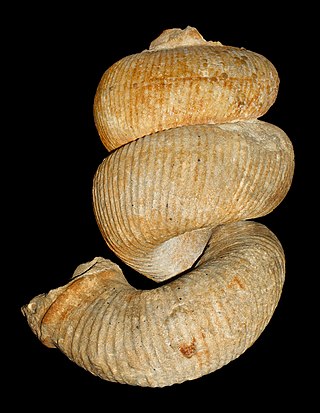
Bostrychoceras is a genus of heteromorph ammonite from the family Nostoceratidae. Fossils have been found in Late Cretaceous sediments in Europe and North America.
Heteroceras is a Lower Cretaceous heteromorph ammonite belonging to the ancyloceratoidean family, Heteroceratidae.
Zetoceras is an extinct ammonoid cephalopod genus from the suborder Phylloceratina that lived during the Early and Middle Jurassic in what is now Europe, and is included in the (family) Phylloceratidae.

Hypophylloceras is a Cretaceous ammonite with a finely ribbed, compressed, involute shell; some having periodic stronger ribs or folds. The suture is complex, with large, asymmetric and finely divided lobes; the 1st lateral being much larger than the external (=ventral) and 2nd lateral lobes. Saddle endings commonly not phylloid.

Neocomites is a genus of ammonite from the Lower Cretaceous, Berriasian to Hauterivian, and type genus for the Neocomitidae.

Neocomitidae is a family of Lower Cretaceous ammonitids comprising genera with strongly ribbed evolute to smooth, fairly involute shells.
Pseudohaploceras is a genus of desmosceratid ammonites from the Early Cretaceous; Valanginian to Albian epochs.

Spitidiscus is a genus of ammonites placed in the family Holcodiscidae.
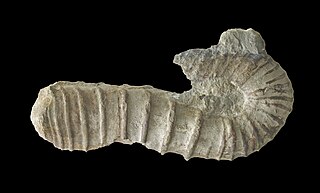
Hamulina is an extinct ammonoid cephalopod genus belonging to the family Hamulinidae. These cephalopod were fast-moving nektonic carnivores. They lived during the Cretaceous period, Barremian age. The type species is Hamulina astieriana.

Hemihoplites is an extinct genus of ammonoid cephalopods belonging to the family Hemihoplitidae. These fast-moving nektonic carnivores lived in the Cretaceous period, from Hauterivian age to Barremian age.

Holcodiscidae is an ammonite family placed in the superfamily Desmoceratoidea.
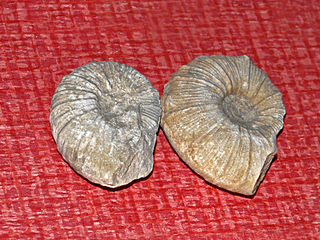
Holcodiscus is an extinct ammonite genus placed in the family Holcodiscidae. Species in this genus were fast-moving nektonic carnivores. The type species of the genus is Ammonites caillaudianus.

Parkinsoniidae is a family of ammonites belonging to the order Ammonitida. The cephalopod family lived from the Bajocian stage to the Bathonian age of the Middle Jurassic.














